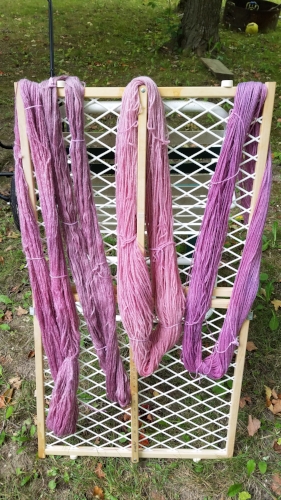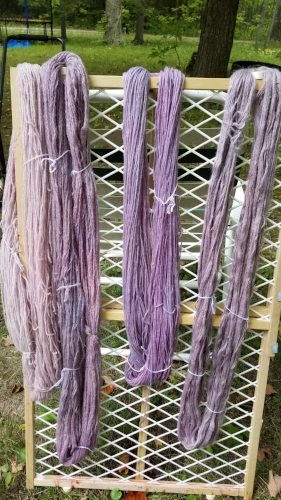Before the final rinse. See all the grapey goodness?
So, my dear husband arrived with a bucket full of wild grapes. He squished them to make bottles of grape juice with a distinct, not unpleasing wild and musky flavor (after adding a bunch of sugar). There was still quite a lot left, and he asked if I wanted to use some to dye some yarn.
Well!
That sounds kinda fun!
I looked up a bunch of information online, squished it together much like the grape juice, and jumped in!
The naked wools before meeting the grapes
My process:
Find natural yarn in stash. I used 4 hanks of lovely wool, all different kinds, from Cascade 220 to local fibers in specific sheep breeds, and one unlabeled surprise. It ended up being about 18 oz of yarn.
In the above picture, the yarns are (from left to right) from Wisconsin Highlands Farms (bought at the Madison Farmer’s Market), White Dog Farm Lincoln Longwool Lamb sportweight (from Forestville, WI), Cascade 220 100% Peruvian Highland Wool, and an unlabeled yarn that looks similar to the first one.
Mix up a mordant. I used 1.3 oz of alum (various online instructions suggested up to 10% of dry weight of yarn, and that too much makes the wool rough, so that’s how I chose 1.3 oz) in enough filtered water to cover the yarn. I filtered the water because our well water has heavy amounts of iron and can make anything orange. Orange and purple don’t mix well. So, bring the mix to a boil, place yarn in water, and remove from heat. Let yarn sit in mixture for an hour as it cools.
Grapes approaching the boil
Prepare dye. Mash up the grapes. Add water (2 parts water to 1 part substance is the advice I read). Bring to a boil for 1 hour. Let cool a bit, and filter out the solid bits. Add yarn to the liquid. Let sit overnight.
Introducing the wool to the grape
In the morning, I decided to try a citric acid soak to help set the dye. 3 teaspoons citric acid to 12 cups water, dissolved. I rinsed the yarn in tepid water (not as thoroughly as I should have… a LOT of color came out!) and soaked the yarn in the mixture for about 30 minutes (10 probably would have been enough, but I was distracted). Squeeze each hank out, wrap in a burrito of plastic wrap, and microwave 1 min, twice. Each hank done separately.
After my incomplete rinse out of the dye, but also a citric acid soak.
Then I placed all the yarn out in the yard to dry. I am amazed by the different colors! One is a light pink, one a dusty gray-purple, one more of a purple-ish pink, and one has features of purple that I would call grape. A big surprise! As I write this, the yarns are out drying. However, I am thinking that I didn’t rinse the dye out well enough. I might go out with a bucket and some wool wash and see if I can get them to the point at which they no longer drip colors. I don’t want any surprises when I use this yarn to make something!
So, washed in lukewarm water with Eucalan, rinsed until water ran clean, and rehang the yarn again. Final picture:
Rearranged the order of the hanks too, but overall a lot less color intensity
In the last picture, I believe the Left furthest is the Cascade 220, which was really the one to take the dye the least, and looked pale pink right from the beginning. The next one is likely the unlabeled one, the third is from Wisconsin Highland Farms, and the right end is the White Dog Farm wool, which was more cream than white, and took on a gray-purple cast.
The color isn’t fully accurate in the last picture, either. The colors have more pinks and magentas in them, although they are certainly more pastel than I had expected. I like them, still, and am happy I got to experiment with dying, and didn’t have to use harsh chemicals. Next time I get an urge, I think I will try the Kool-Aid dye strategy!






